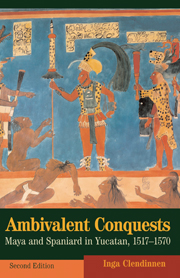Book contents
- Frontmatter
- Contents
- List of illustrations
- Preface to the second edition
- Preface to the first edition
- Acknowledgments
- Map I Yucatan in the conquest period
- Part I Spaniards
- Part II Indians
- Epilogue: Confusion of tongues
- Appendix: A sampler of documents
- Glossary of Spanish and Maya terms
- Notes
- Select bibliography
- Index
Preface to the first edition
Published online by Cambridge University Press: 05 October 2013
- Frontmatter
- Contents
- List of illustrations
- Preface to the second edition
- Preface to the first edition
- Acknowledgments
- Map I Yucatan in the conquest period
- Part I Spaniards
- Part II Indians
- Epilogue: Confusion of tongues
- Appendix: A sampler of documents
- Glossary of Spanish and Maya terms
- Notes
- Select bibliography
- Index
Summary
South and west of Cuba a great limestone peninsula thrusts into the warm waters of the Caribbean. The Maya Indians who lived there called it ‘The Land of the Turkey and Deer’, for they thought it a rich place. In the early years of the sixteenth century Spaniards came; some in search of a golden kingdom, some to extend the Kingdom of God. They found a harsh and stony land which they conquered and settled nonetheless. They named it ‘Yucatan’.
This is a story of how the Land of the Turkey and the Deer was made into Yucatan. Proud of their exploits, the conquerors recorded them in detail, so the tale of exploration and war can be told, first, from their point of view, and in their terms – of courage, unabashed cupidity, and that extraordinary European conviction of their right to appropriate the world. Later we hear Spanish voices still, but Spanish voices raised in confused and bitter conflict, as settlers and missionary friars fought a dangerous battle for the power to determine the kind of Yucatan they would make. They fought not only over the use of land and control of labour, the conventional problems of colonial politics, but over contrary accounts of the conduct and the nature of the subject native people. In the course of that struggle about the nature of the alien and other, they were sometimes forced to unsought and profoundly disquieting discoveries about themselves – which is always a danger in the hall-of-mirrors world we make when we seek to possess the strange and make it part of ourselves.
- Type
- Chapter
- Information
- Ambivalent ConquestsMaya and Spaniard in Yucatan, 1517–1570, pp. xv - xviPublisher: Cambridge University PressPrint publication year: 2003



